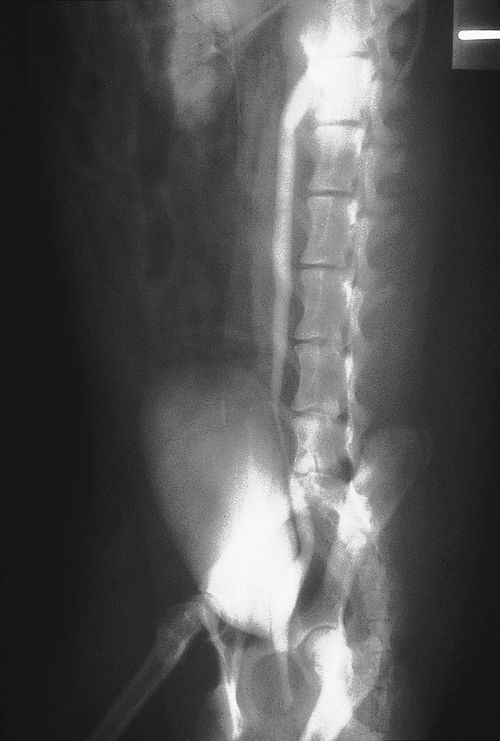Difference between revisions of "Small Animal Soft Tissue Surgery Q&A 13"
Ggaitskell (talk | contribs) |
|||
| (2 intermediate revisions by 2 users not shown) | |||
| Line 1: | Line 1: | ||
| + | {{Template:Manson | ||
| + | |book = Small Animal Soft Tissue Surgery Q&A}} | ||
| + | |||
| + | |||
[[Image:SA ST Sx 13.jpg|centre|500px]] | [[Image:SA ST Sx 13.jpg|centre|500px]] | ||
<br /> | <br /> | ||
| − | '''This is a one-year-old, female | + | '''This is a one-year-old, female Terrier mixbreed presented for intermittent dribbling since its acquisition at three months of age. This dog periodically voids the bladder normally.''' |
<br /> | <br /> | ||
| Line 15: | Line 19: | ||
The condition occurs most frequently in Siberian Huskies, Newfoundlands, Terriers, Golden and Labrador Retrievers and Toy Poodles; the mode of inheritance is unknown. | The condition occurs most frequently in Siberian Huskies, Newfoundlands, Terriers, Golden and Labrador Retrievers and Toy Poodles; the mode of inheritance is unknown. | ||
| − | |l1= | + | |l1=Ureteral Ectopia |
|q2=What are five morphologic variations of this anatomic anomaly? | |q2=What are five morphologic variations of this anatomic anomaly? | ||
|a2= | |a2= | ||
| Line 24: | Line 28: | ||
*Intramural ureter with a normal opening and a ureteral trough continuing distal to the sphincter. | *Intramural ureter with a normal opening and a ureteral trough continuing distal to the sphincter. | ||
*Extramural ureter that enters directly into the vagina or urethra without penetrating the bladder wall. | *Extramural ureter that enters directly into the vagina or urethra without penetrating the bladder wall. | ||
| − | |l2= | + | |l2=Ureteral Ectopia |
|q3=What are the methods of choice for assessing the ureteral pathway and its termination? | |q3=What are the methods of choice for assessing the ureteral pathway and its termination? | ||
|a3= | |a3= | ||
| Line 32: | Line 36: | ||
Radiography cannot be used to identify the morphologic type of ectopic ureter. | Radiography cannot be used to identify the morphologic type of ectopic ureter. | ||
| − | |l3= | + | |l3=Ureteral Ectopia#Diagnosis |
</FlashCard> | </FlashCard> | ||
Latest revision as of 13:38, 19 October 2011
| This question was provided by Manson Publishing as part of the OVAL Project. See more Small Animal Soft Tissue Surgery Q&A. |
This is a one-year-old, female Terrier mixbreed presented for intermittent dribbling since its acquisition at three months of age. This dog periodically voids the bladder normally.
| Question | Answer | Article | |
| What diagnosis is suggested by the contrast study? | The excretory urogram shows ureteral ectopia; here the dilated left ureter drains into the urethra. It is a congenital disorder where one (70–80% of dogs) or both ureters (most cats) terminate and drain at a site other than the urinary bladder, most often in the urethra or vagina. The condition occurs most frequently in Siberian Huskies, Newfoundlands, Terriers, Golden and Labrador Retrievers and Toy Poodles; the mode of inheritance is unknown. |
Link to Article | |
| What are five morphologic variations of this anatomic anomaly? | The five morphologic variations of this anatomic anomaly are:
|
Link to Article | |
| What are the methods of choice for assessing the ureteral pathway and its termination? | An excretory urogram in conjunction with pneumocystogram is useful to assess the presence or absence of an ectopic ureter. Vagino-urethrography is also useful for evaluating the termination of the ureter. Radiography cannot be used to identify the morphologic type of ectopic ureter. |
Link to Article | |
